Parpataka Uses, Research, Side Effects, Medicines
Parpataka is an effective Ayurvedic herb used in fever, high Pitta conditions such as fever, gastritis, diarrhoea, excessive thirst etc. Its famous herbal remedy – Shadanga Paneeya (drink made out of six herbs) is used in treating fever and associated thirst.
Table of Contents
Botanical name
There are many botanical species used with the name Parpataka –
Fumaria parviflora Lam., Fumaria officinalis, Fumaria indica Pugsley, Justicia procumbens, Oldenlandia corymbosa, Polycarpaea corymbosa – All these are used in the name of Parpata.
Mollugo cerviana and Mollugo oppositifolia are used in Tamil Nadu and Andhra Pradesh as Parpataka.
Hedyotis corymbosa is used as Parpataka in Kerala.
Rungia repens is used in Gujarat
Rungia parviflora – in Maharashtra
Fumaria officinalis, also called as Common Fumitory. It is found in Europe.
Other names –
Polycarpea corymbosa Lam,
Glossocardia linearifolia Cass,
Justicia procumbens Linn,
Fumaria officinalis Linn,
Mollungo stricta Linn,
Rungia repens Nees etc.
Distribution
Fumaria indica and Hedyotis corymbosa are commonly found weeds throughout India and Pakistan.
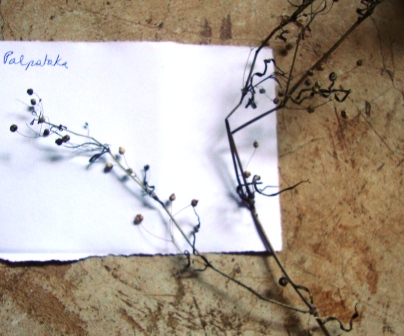
Vernacular names
Names in different languages:
English name – fine leaf fumitory, fine-leaved fumitory and Indian fumitory.
Hindi name- Pitta Papada, Dham Gajara, Pitpapra, Pitpapda
Arabic name- Sahtaraj
Tamil name- Tura
Telugu name- Parpatakamu, Chatarasi
Punjabi name – Shahtara
Farsi name – Shah Taraj
Malayalam name – Parppadakam
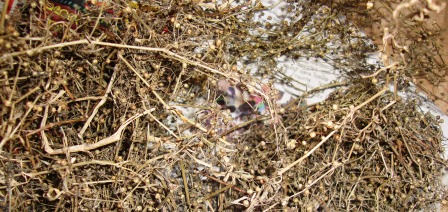
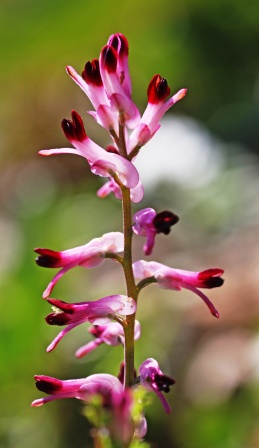
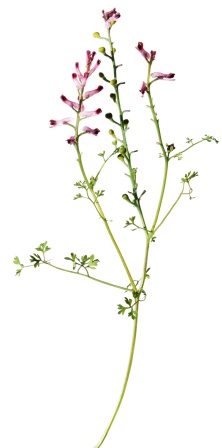
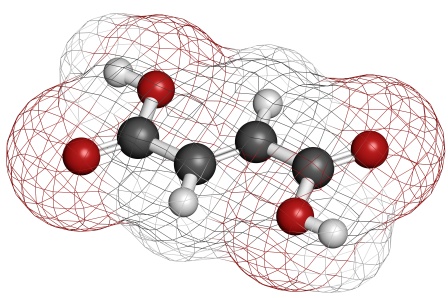
Medicinal properties
Parpata – Medicinal Properties:
Guna (qualities) – Laghu (lightness)
Rasa (taste) – Tikta (bitter)
Vipaka-Katu – Undergoes pungent taste conversion after digestion
Veerya – Sheeta – cold potency
Effect on Tridosha – Balances Kapha and Pitta Dosha. Slightly increases Vata Dosha.
Pharmacological action – Anti microbial, Antipyretic, Anti – inflammatory, Hepato protective, Diuretic, Antispasmodic
As mentioned in Bhojana Kutuhalam twelfth chapter, parpata alleviates pitta and rakta dosha, treats jwara, thirst, vitiated kapha dosha, giddiness and is grahi. It is cold in potency, bitter in taste, burning sensation, aggravates vata dosha and is light to digest.
Whole plants can be used and the leaves are rich with medicinal properties.
The plants are collected from the wheat and Rice fields where it is found as weed.
The plant is a good cholagogue (pitta saraka) as well.
Ayurvedic texts appreciate its qualities as bitter and astringent in taste, followed with cold in potency and sweet bio transformation. It is indicated in fever, cold, blood borne disorders, goiter etc.
The plant is a good cholegogue (pitta saraka) as well.
Ayurvedic texts appreciate its qualities as bitter and astringent in taste, followed with cold in potency and sweet bio transformation. It is indicated in fever, cold, blood borne disorders, goitre etc.
Part used, dosage
Part used- whole plant
Dosage-
Powder 3-6 g
Decoction – Kashaya – 50-100 ml in divided dose per day.
Morphology
Annual herb
Tap root, branched
Stem – Herbaceous, erect, branched, solid with watery juice
Leaf – Simple, segments narrow and flat leaves alternate or opposite, exstipulate and petiolate
Inflorescence – Raceme
Flower – Small, whitish or pinkish, tips are purple, sepals are 2 in number, small and greenish in colour, petals are 4 in number
Fruit -Globose nut, 1 seeded,
Seed -Minute, black and albuminous
Useful part – Whole plant
Home remedies
Indian Fumitory remedies:
Intermittent fever, cold, jaundice
Pit Papda decoction in chikungunya, PUO, intermittent fevers, cold and jaundice:
Fresh or dried Parpataka – whole plant is taken (20-30 gram) and decoction is made by boiling with 240-300 ml of water. This is taken twice daily. In case of intermittent fevers it is prescribed 3-4 times a day. This is effective in conditions like Dengue, chikungunya, PUO, intermittent fevers, cold and jaundice.
General method of preparation of decoction (kashaya) – 1 tablespoon of powder is added with 2 cups of water, boiled and reduced to 1 cup, filtered.
Obstructive jaundice, bilious headache
Leaf fine paste along with buttermilk for obstructive jaundice and bilious headache:
Fine paste of the whole plant or leaves is taken along with buttermilk. This traditional practice is continued even today in South Canara district of Karnataka state. This is effective in bilious headache and obstructive jaundice.
Pimples, urticarial rashes
Sariva (Hemidesmus indicus) and Parpataka decoction for pimples, urticarial rashes and boils:
Equal amounts of Sariva (Hemidesmus indica) and Parpataka are taken and decoction is made. This is useful in all age groups. It is found to be effective in pimples, allergic hives and boils.
Burning sensation of body
Cold infusion of Parpataka and Usheera in vertigo, syncope and burning sensation of the body:
Parpataka and Usheera (Vetiveria zizanioides) are taken in equal amounts and cold infusion is prepared. This is administered in the dose of 40-60 ml twice daily. This is effective to pacify the vertigo, syncope and burning sensation of the body.
Constipation, hemorrhoid’s
Parpataka, licorice and Raisins decoction or hot infusion for constipation and hemorrhoid’s:
The decoction or hot infusion prepared out of the drugs Parpataka, Yastimadhu (Glyccirhiza glabra) and Raisins (Vitis vinifera Linn) acts effectively on hemorrhoids, constipation and IBS.
Parpataka in combination with Musta (Cyperus rotundus), Nimba (Azadirachta indica), Nagara (Zingiber officinale), Saptaparna (Alstonia scolaris) etc shows its highly significant effects while treating fever of unknown origin, antibiotic resistant illnesses and liver disorders.
Click to consult Dr MS Krishnamurthy MD(Ayu), PhD
Sanskrit verse
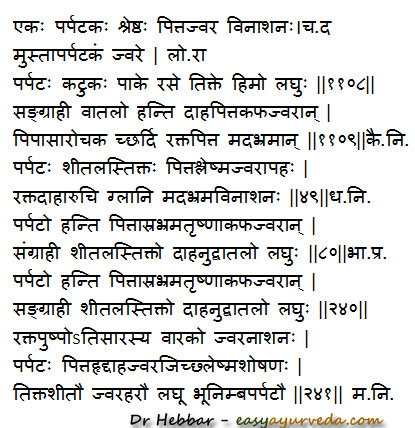
Parpataka benefits
Parpataka is best to treat Fever of Pitta origin.
Musta (cyperus rotundus) and Parpataka are best herbs for fever
Sangrahi – absorbent, bowel binding, useful in IBS, diarrhea
Vatala – increases Vata Dosha
As per Ashtanga Hrudaya 6/75-78 – Parpata is cold in potency, bitter in taste, pungent at the end of digestion, with hold the movement of fluids, increases vata and mitigates kapha and pitta.
Parpataka kashaya (decoction of Parpata) subsides the poisonous effects caused by Bhallataka seeds or oil. – Vaidya Sara Sangraha – Parishishta.
Indications
It is indicated in:
Daha – Burning sensation
Kaphaja Jwara – fever of Kapha origin
Pittaja Jwara – fever of Pitta origin
Pipasa – excessive thirst
Arochaka – anorexia, lack of interest in food
Chardi – vomiting
Raktapitta – bleeding disorders like nasal bleeding, Ulcerative colitis and menorrhagia
Mada – intoxication
Bhrama – dizziness, psychosis
Glani – tiredness, weakness of sense organs
Its red flowers are indicated in
Atisara – dysentery, diarrhea
Fumaria officinalis, also called as Common Fumitory, is useful against spasmodic pain, skin disorders, eye disorders, cardiac disorders.
Mollugo oppositifolia is used as laxative, antiseptic, in earache, itch & dermatitis.
Ayurvedic medicines
Ayurveda medicines with Parpata as ingredient:
Parpatakarishtam – used in anemia, jaundice, hepatomegaly, splenomegaly
Chinnodbhavadi Kashayam – It is used in the Ayurveda treatment of fever, chronic recurrent fever.
Pachanamrita Kashayam – used in early stages of fever, where digestion is severely impaired.
Panchatiktaristam – Acts as antipyretic and blood purifier.
Gulma Kalanal Ras – used in the Ayurveda treatment of abdominal distension, bloating, etc.
Chemical constituents
Fumaria parviflora – chemical constituents
Adlumidiciceine,(-) adlumine,(+) biscuculline, Cochaurine, Coptisine, Cryptopine, Furmaramine, Fumaramidine, Fumaridine, Fumariline, Lahoramine, Lahorine, Parfumidine, parfumine, Parviflorine, Narceimine etc
(Reference: Illustrated Dravyaguna VIjnana, Vol. II, by Dr JLN Shastry)
Fumaric acid and fumarine are the two important chemical constituents which act as antihistamine, blood purifier, immuno modulator, diaphoretic, antipyretic and anti-tussive.
Research
Antimicrobial Activity of Mollugo cerviana – Ethanolic extracts of aerial shoots of Mollugo cerviana and its leaf derived callus showed antibacterial activity against Bacillus subtilis and Escherichia Coli.
Side effects
There are no known side effects with this herb.
It can be used in children (since it is an ingredient of Pediatric medicine called Aravindasavam) and during the lactation period.
Seek medical guidance for its usage during pregnancy.
Interaction with medicines, supplements
Can this be used while taking Homeopathic medicine?
Yes. This product does not react with homeopathic medicine.
Can this medicine be continued while taking supplements like multivitamin tablets, Omega 3 fatty acids etc.?
Yes. Generally, this product goes well with most dietary supplements. However, if you are taking more than one product per day, please consult your doctor for an opinion.
With western
medicines
Seek your
doctor’s advice if you are taking this product along with other western
(allopathic / modern) medicines. Some Ayurvedic herbs can interact with modern
medicine.
If both Ayurvedic and allopathic medicines are advised together, then it is
best to take Allopathic medicine first, wait for 30 minutes and then take the
Ayurvedic medicine.
Sanskrit synonyms
Sutiktaka, Varatikata – greatest bitter tasting herb
Sookshma Patra – pointed small leaves
Pittaha – balances Pitta Dosha
Pragandha – Have strong odour
Kshetra parpata – parpata grows in field
Sheetavallabha, Charmahva, Rajo Renu, Varma Kantaka
Classical categorisation
Charaka- Trushna nigrahana – group of herbs useful in quenching thirst
Raja Nighantu – Parpatadi Varga
Kaiyyadeva Nighantu – Aushadhi Varga
Bhavaprakasha Nighantu, Dhanvantari Nighantu – Guduchyadi Varga
Madanapala Nighantu – Abhayadi Varga
Sthanika Karma (Systemic Action)
Internal administration-
Nervous system – Calms down the nervous system. Indicated in conditions like giddiness, Alcoholic intoxication, fainting etc.
Digestive System – Relieve thirst, Carminative, Absorbent, Stimulate liver, Anthelmintic. Indicated in Excessive thirst, Anorexia, Loss of appetite, Helminthiasis, Jaundice.
Circulatory System – Remove toxins and purify blood. It has styptic action. Indicated in bleeding disorders, Vatarakta (Rheumatic Arthritis, Gout) etc.Excretory System – Indicated in Dysuria
Satmikarana –Indicated in conditions like general weakness after diarrhea etc.
Tvak (Skin) – Indicated in skin diseases, Svedajanana (Helps to produce sweat)
Tapakrama – Indicated in fever associated burning sensation.











One comment
Ashwin
Can you use this for hair wash ?